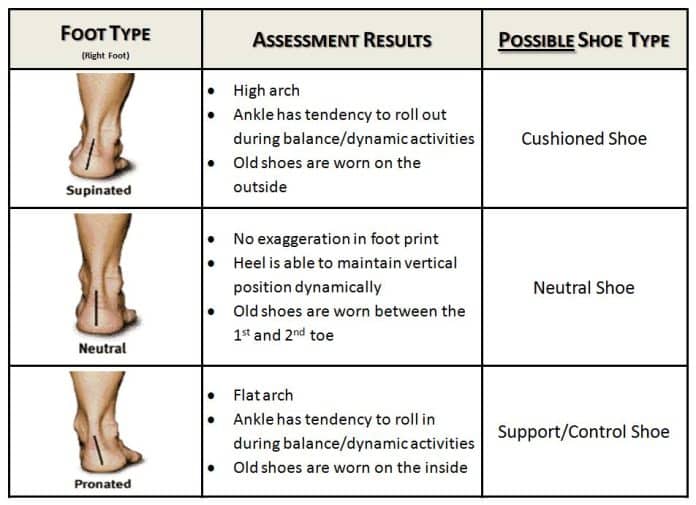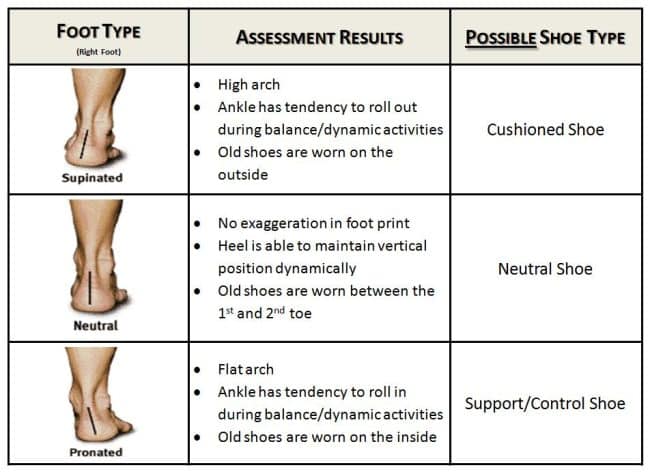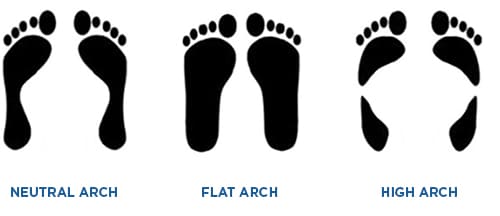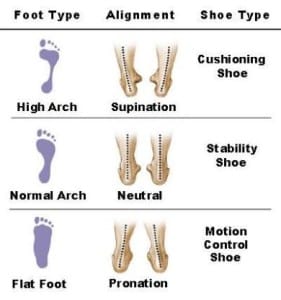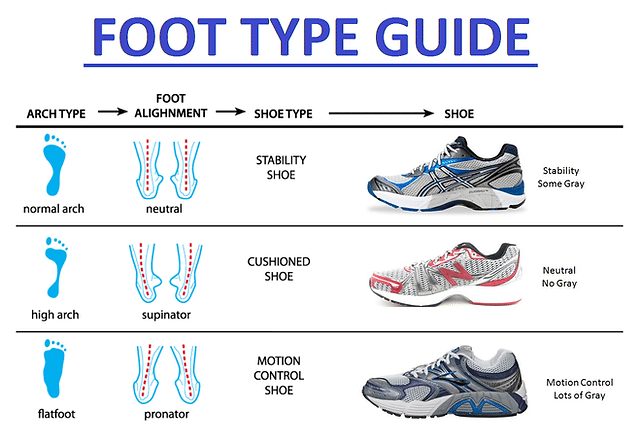Choosing the perfect running shoes for our unique foot type can often be a daunting task. With so many options available, it’s easy to feel overwhelmed and unsure of where to start. However, fear not, because in this article, we will guide you through the process of selecting the right type of running shoes based on your specific foot type. Whether you have high arches, flat feet, or somewhere in between, we’ve got you covered. So lace up your shoes and join us as we embark on a journey to find the perfect fit for your feet.
Review contents
Factors to Consider
When it comes to choosing the right type of running shoes, there are several factors that we need to take into consideration. These factors include arch type, pronation, shoe size, foot shape, and running terrain. By understanding these factors and how they relate to our specific foot type, we can ensure that we find the perfect pair of running shoes that provide us with the comfort and support we need.
Arch Type
Arch type refers to the shape of our foot’s arch, which can be categorized as either low, normal, or high. It is important to determine our arch type as it affects the way our feet absorb and distribute impact while running. We can determine our arch type through various methods such as the wet test, footprint test, or consulting a podiatrist.
This image is property of dealnews.a.ssl.fastly.net.
Pronation
Pronation is the natural inward rolling motion of our foot during each step. Understanding our pronation pattern is essential in selecting the right type of running shoes. There are three primary types of pronation: neutral pronation, overpronation, and supination. Each pronation type requires a specific type of shoe to ensure proper alignment and reduce the risk of injury.
Shoe Size
Selecting the correct shoe size is crucial in ensuring maximum comfort and preventing any foot-related injuries. To determine our shoe size, we should measure both the length and width of our feet accurately. It is advisable to measure our feet later in the day when they are at their largest due to walking or running.
This image is property of health.uconn.edu.
Foot Shape
Foot shape refers to the overall structure of our feet, particularly in terms of width and volume. Understanding our foot shape is essential in finding running shoes that provide a secure fit and proper support. Feet can be categorized as narrow or wide, and selecting the appropriate shoe width can greatly enhance our running experience.
Running Terrain
The running terrain plays a significant role in determining the type of running shoes we need. Whether we run predominantly on roads or trails, there are specific shoe features that cater to each terrain. For road running, we require shoes that provide cushioning and stability on hard surfaces. On the other hand, trail running shoes should have sturdy outsoles and increased traction to handle uneven and unpredictable terrain.
This image is property of lifestylephysio.com.au.
Types of Running Shoes
Now that we understand the key factors to consider, let’s explore the different types of running shoes available in the market. These include stability shoes, motion control shoes, cushioned shoes, and minimalist shoes. Each type of shoe offers unique benefits and features that cater to specific foot types and running conditions.
Stability Shoes
Stability shoes are designed for runners with mild to moderate overpronation. They feature a combination of cushioning and support to provide stability and reduce excessive inward rolling of the foot. These shoes typically have a firm midsole and a denser medial post to control pronation and maintain proper alignment.
Motion Control Shoes
Motion control shoes are specifically designed for runners with severe overpronation. They offer maximum support and stability to control excessive inward rolling of the foot. These shoes often have a firm, straight last and a reinforced medial post to prevent overpronation and promote a more neutral gait.
Cushioned Shoes
Cushioned shoes are ideal for runners who prioritize comfort and shock absorption. These shoes utilize extra cushioning materials in the midsole to provide a soft and plush feel. They are suitable for neutral pronators and runners with high arches who require additional cushioning to absorb impact effectively.
Minimalist Shoes
Minimalist shoes, also known as barefoot shoes, are designed to mimic the natural movement and experience of running barefoot. These shoes have a minimalistic design with a low heel-to-toe drop and flexible soles. They are suitable for experienced runners with proper biomechanics and strong feet who desire a more natural running experience.
Choosing the Right Shoe for Different Foot Types
Now that we have familiarized ourselves with the different types of running shoes available, let’s explore how to match these shoes with different foot types. The three main foot types we will focus on are neutral feet, high-arched feet, and flat feet.
Neutral Feet
If you have neutral feet, congratulations! You have the most biomechanically efficient foot type. People with neutral feet have a natural inward rolling motion that helps absorb shock evenly. For those with neutral feet, stability shoes and cushioned shoes are suitable options as they provide a good balance of support and cushioning.
High-Arched Feet
Individuals with high-arched feet have a distinctive curve along the inner edge of their foot. This foot type tends to be rigid and may not naturally absorb shock as effectively as other foot types. Runners with high-arched feet should opt for cushioned shoes to provide ample shock absorption and reduce the risk of injury.
Flat Feet
Having flat feet means your arches are lower, which can result in overpronation and reduced shock absorption. Runners with flat feet should consider stability shoes or motion control shoes. These types of shoes provide the necessary support and stability to control overpronation and maintain proper alignment throughout the running motion.
This image is property of static.wixstatic.com.
Determining Your Arch Type
To determine our arch type accurately, there are a few simple tests we can perform at home or consult a podiatrist for a professional assessment.
Wet Test
One popular method is the wet test. Here’s how it works: Wet the sole of your foot, step on a piece of cardboard or a dark-colored surface, and observe the shape of your footprint. If you see a half-moon-shaped arch filled with a moderate amount of space, you likely have a normal arch. If your footprint shows a narrow arch or no arch at all, you have low arches. If your footprint indicates a very narrow or no visible arch, you likely have high arches.
Footprint Test
Another method is the footprint test. Place a piece of paper on the floor and step on it with your bare, slightly wet foot. Observe the shape of your footprint. A normal arch will show a moderate curve along the inner edge, while a flat foot will have a complete or almost complete footprint with little to no curve.
Consulting a Podiatrist
For a more accurate assessment, it is advisable to consult a podiatrist. They can perform detailed examinations, use specialized equipment, and provide personalized recommendations based on your specific foot type and any related concerns.
Understanding Pronation
As mentioned earlier, understanding our pronation pattern is crucial in selecting the right running shoes. Let’s delve deeper into the three primary types of pronation: neutral pronation, overpronation, and supination.
Neutral Pronation
Neutral pronation occurs when the foot rolls inward slightly upon landing but remains in a stable and aligned position. Runners with neutral pronation enjoy efficient shock absorption and an even distribution of impact. Stability shoes and cushioned shoes are ideal for individuals with neutral pronation.
Overpronation
Overpronation happens when the foot excessively rolls inward during each step. This can lead to an imbalance and place additional stress on the foot and lower leg. Overpronators should opt for stability shoes or motion control shoes to provide support and prevent excessive inward rolling.
Supination
Supination, also known as underpronation, occurs when the foot doesn’t roll inward enough during the running motion. This results in more pressure on the outer edge of the foot and reduced shock absorption. Runners with supination should look for cushioned shoes that offer ample shock absorption and cushioning.
This image is property of www.stewardtoday.com.
Selecting the Right Shoe Size
Choosing the correct shoe size is vital for comfort and preventing foot-related issues. Here are some factors to consider when determining the right size:
Measurements
Measure both the length and width of your feet accurately. Use a ruler or a measuring tape to measure from the back of your heel to the tip of your longest toe. Ensure that you have at least a thumb’s width of space between your longest toe and the end of the shoe.
Toe Space
Allow sufficient space for your toes to move freely within the shoe. A cramped toe box can lead to discomfort, blisters, or even toenail damage. The ideal shoe should provide enough room for natural toe splay.
Width
Consider your foot width when selecting running shoes. Different shoe brands offer various width options to accommodate narrow, medium, and wide feet. Ensuring the appropriate shoe width contributes to overall comfort and a secure fit.
Sock Thickness
Remember to consider the thickness of the socks you typically wear while running. If you usually wear thicker socks, you may need to size up slightly to accommodate the additional thickness.
Considering Foot Shape and Width
Now that we have discussed shoe size, let’s shift our focus to foot shape and width. Understanding our foot shape is essential in finding running shoes that provide a secure fit and proper support.
Narrow Feet
If you have narrow feet, it can be challenging to find shoes that offer a snug fit without excessive movement. Look for shoe models that offer narrower widths or customizable lacing systems to achieve a secure fit. Additionally, consider using thicker socks or using cushioned insoles to add volume to the shoe.
Wide Feet
Individuals with wide feet require shoes that offer ample width and volume to prevent discomfort and potential foot-related issues. Look for shoe models that provide wider width options to accommodate your foot shape. Enhanced cushioning and a stretchable upper can also provide a more accommodating fit.
Matching Shoes with Running Terrain
The type of running terrain we frequent also influences the choice of running shoes. Let’s explore two common terrains: road running and trail running.
Road Running
For those who primarily run on roads or paved surfaces, it is essential to select shoes specifically designed for road running. Road running shoes feature cushioning and stability to absorb impact on hard surfaces effectively. They usually have a smooth and durable outsole optimized for road traction.
Trail Running
For runners who prefer off-road adventures and trail running, specialized trail running shoes are necessary. These shoes provide enhanced traction, durability, and protection to handle unpredictable terrain. Look for shoes with aggressive outsoles, rock plates, and toe guards to ensure a secure and comfortable experience on the trails.
Trying on and Testing the Shoes
After considering all the essential factors, it’s time to try on and test the shoes to ensure the perfect fit and performance.
Flexibility
Bend the shoe at the ball of the foot to assess its flexibility. A good running shoe should provide a flexible forefoot to aid proper toe-off during each stride. This flexibility contributes to an efficient and natural running gait.
Comfort
Walk or jog around the store in the shoes to evaluate their comfort. Pay attention to any areas of discomfort or irritation. Ensure that the shoes feel snug but not tight, with no pressure points or rubbing.
Insole and Padding
Evaluate the insole of the shoes for comfort and cushioning. Consider whether you may require additional arch support or customized insoles to enhance comfort and support for your specific foot type.
Stability and Support
Test the shoes for stability by performing lateral movements. The shoes should provide sufficient support and prevent excess movement and rolling of the foot to promote a stable running experience.
Consulting a Professional
If you have any specific concerns or need expert advice, it can be beneficial to consult a professional. Two professionals who can provide valuable insights are running store specialists and podiatrists.
Running Store Specialist
Running store specialists are knowledgeable professionals who can analyze your gait, foot type, and running needs. They can guide you through the selection process, recommend suitable shoe options, and provide valuable insights based on their experience and expertise.
Podiatrist
If you have chronic foot issues, previous injuries, or specific biomechanical concerns, consulting a podiatrist is highly recommended. A podiatrist can provide a thorough assessment, diagnose any underlying conditions, and offer personalized recommendations for running shoes based on your specific needs.
In conclusion, choosing the right type of running shoes for our foot type involves considering factors such as arch type, pronation, shoe size, foot shape, and running terrain. By understanding these factors and consulting professionals when needed, we can ensure that our running shoes provide optimal comfort, support, and performance. Remember, finding the perfect pair of running shoes is worth the effort, as they play a crucial role in protecting our feet and enhancing our running experience. Happy running!

